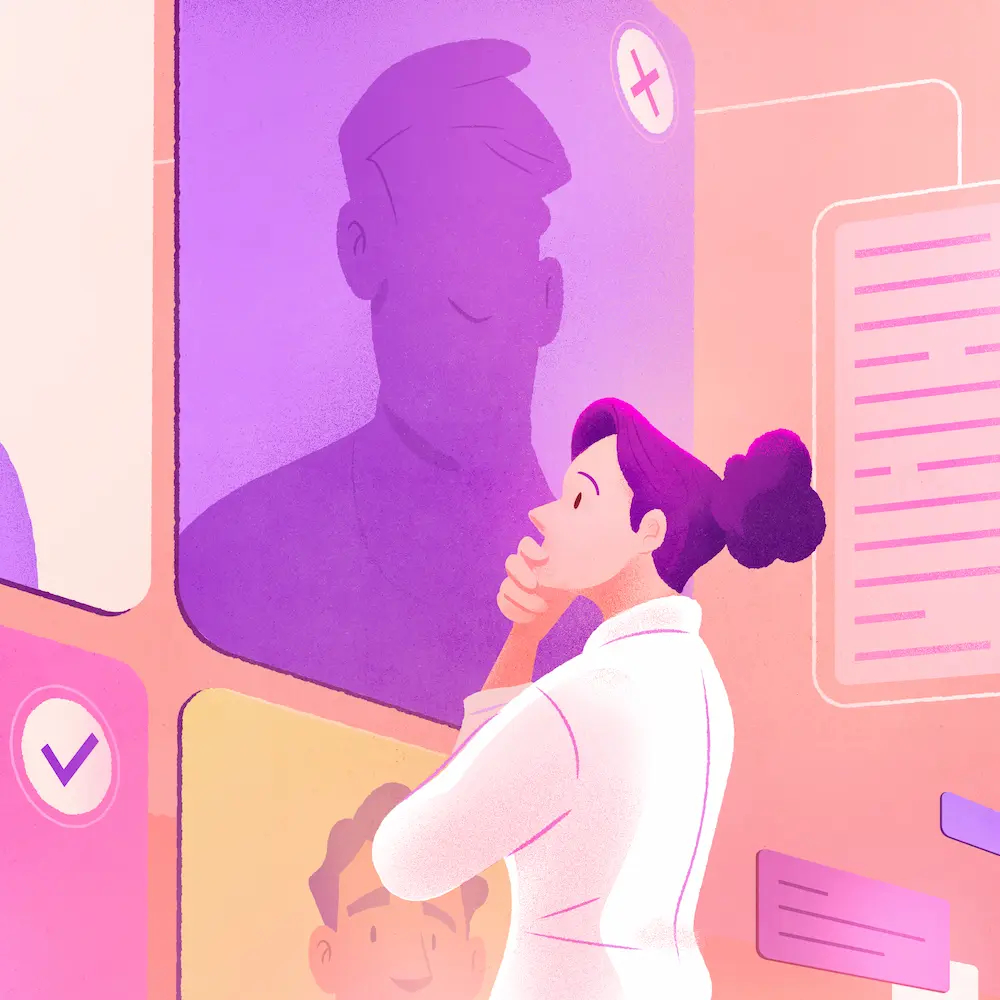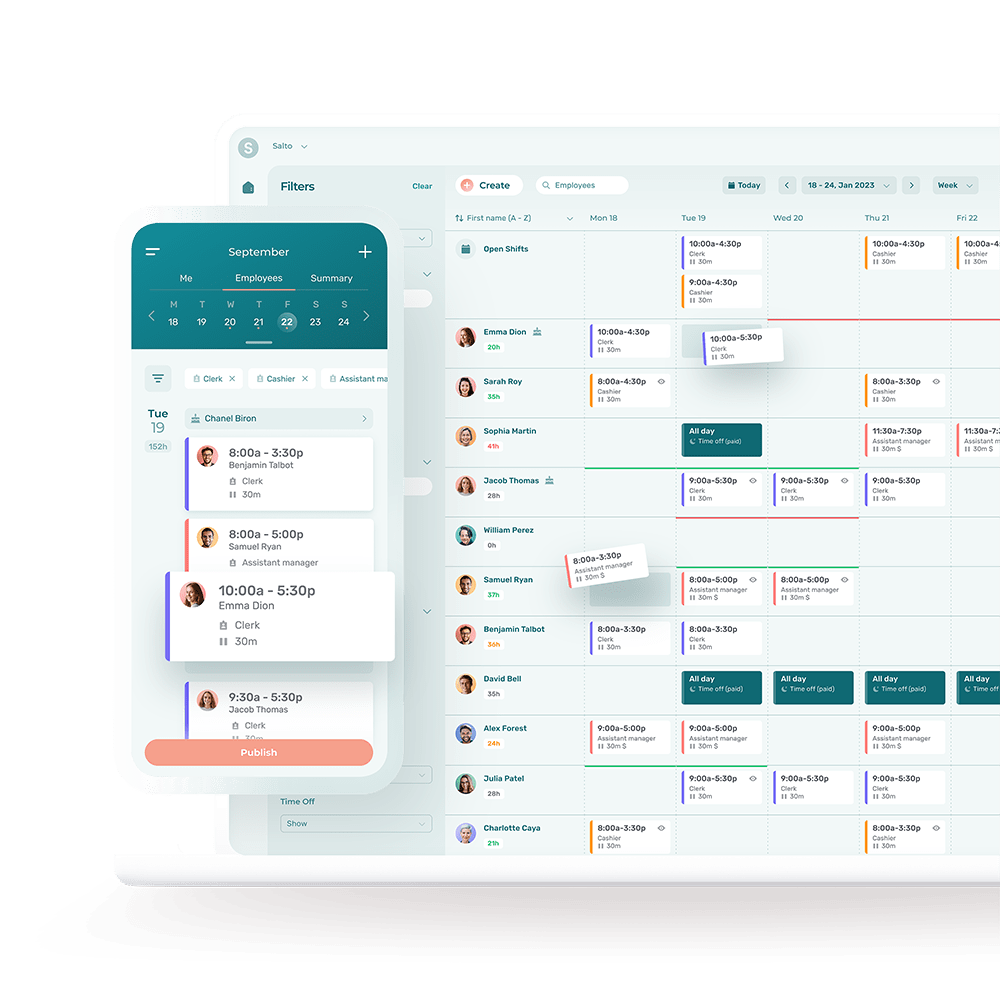In addition to optimizing your operations and making sure that you have the right number of employees present at work, attendance tracking can save your company a great deal of money.
We recently surveyed 669 Canadian managers, all Agendrix customers. The results speak for themselves! Setting up software to track attendance and work hours has enabled them to:
- Save nearly $4,000 a year—and that’s only counting savings on the salaries of the managers in charge of tracking work hours.
- Cut down on the time needed for a manager to track and process work hours by 53%.
Clearly, there is much to be gained from tracking your team’s attendance and work hours. Beyond the savings mentioned above, this article lays out 5 reasons to track your employees’ work hours and different ways of punching in and out, including the pros and cons of each.
5 Reasons to Optimize Your Time Management of Employees’ Work Hours
Here are the chief reasons why employers keep track of their employees’ work hours.
1. Payroll Calculation
The first reason for tracking employees’ work hours is that it’s a requirement in order to carry out a mandatory administrative task… specifically, calculating payroll for a given period of time.
For Annualized Salaries
If you’re hiring employees on an annualized salary, the calculation is generally straightforward: just multiply the number of scheduled hours per week by the pay period. For example, an employee who works 32 hours a week at $18 an hour and is paid every 2 weeks will make $1,152 (32 x 18 x 2) every 2 weeks.
This calculation will be the same for all your employees with an annual salary. All you’ll have to adjust are the hourly wage and number of hours per week if they’re different.
For Hourly Rate Salaries
If, on the other hand, you hire employees with variable weekly work hours who are paid at an hourly rate, the calculation is a bit trickier. It will be different for each employee, depending on their hourly rate, overtime, leave calculation, etc.
Payroll errors are an irritant, both for your employees and for the HR managers or administrators who handle payroll.
Keeping track of attendance and time worked is crucial to ensuring fair and consistent compensation. And this, in turn, will boost morale! 😎
2. Resource Planning, Allocation and Optimization
Attendance tracking will help you better plan resource allocation from one period and year to the next.
Does your business go through peak periods or seasonal ups and downs, as it is common in the tourism industry? Maybe your restaurant needs to double its staff on the Sunday of Mother’s Day, or your retail business has to schedule extra shifts on evenings in December in the run-up to the holidays.
Analyze Attendance Data to Do Things Better
For some industries, scheduling on-call employees will help better allocate resources. Analyzing attendance and work time data will help you uncover trends, but also opportunities for improving your operations.
For example, if you have a particularly high absenteeism rate for the shift on the last Friday of the month, try to find out what’s behind this issue.
- Is it a busier shift?
- Are there more tedious recurring tasks to take care of during this time?
- Do you have younger employees still in school who need to take time off so they can do group assignments?
💡Tracking attendance data will enable you to continuously improve your practices.
3. Employee Accountability
All good managers dream of having independent, responsible, competent and dedicated employees on their team. At least, I’d like to think that’s the dream of managers who believe in their team’s abilities. 🤠
Keeping track of work hours and attendance has a wonderful effect—it empowers staff. And responsible, reliable, empowered employees tend to show up to work on time and perform at a higher level.
By tracking attendance data, you’ll have a solid argument for justifying a promotion to a new position, for example. (Or, conversely, for reprimanding an employee who is a regular no call no show.)
Given that more closely tracking work hours ultimately empowers your employees, you may enjoy a host of benefits. For example, you’ll feel confident about offering greater flexibility:
- By allowing employees to swap shifts without requiring their manager’s approval
- By letting employees apply for shifts without requiring your intervention
All of this can significantly lighten the burden for your managers.
4. Preventing Fraud and Time Theft
Better managing your team’s work hours promotes fairness within your team.
The jury is in: tracking attendance and work time also has tangible benefits for your staff that go far beyond their pay. Time tracking software helps eliminate buddy punching—just one of the many culprits involved in time theft.
It also saves you money by only paying out salaries for hours worked, which enables you to guarantee a degree of fairness for team members.
5. Compliance With Existing Legislation
Whether it’s overtime, breaks between shifts or any other legislation pertaining to work hours, keeping track of hours worked helps establish your compliance with current legislation.
Documenting and keeping a record in your archives, using an attendance register, can be useful on many occasions, such as audits, investigations or simply for administrative follow-ups.
How Do I Keep Track of Work Hours and Attendance?
A variety of tools can be used to track your team’s work attendance, with varying degrees of accuracy. You’ll want to find an option that suits your budget, situation and needs.
4 Ways to Track Attendance With Their Pros and Cons
Timesheets
Good old-fashioned timesheets are still more widespread than you might think. Employees manually record their start, end and break times using paper and pencil, or a card reader.
Pros
- Simple method
- Inexpensive
Cons
- High risk of errors due to multiple transcriptions
- Issues arising from lost timesheets
- Lengthy validation time
Online Timesheets
The modern version of paper! This way of tracking work time requires employees or managers to manually record arrival, departure and break times in a tool such as an Excel spreadsheet.
Pros
- Simple
- Inexpensive
- Information available electronically
Cons
- Substantial handling required for payroll
- High risk of errors due to transcriptions
- Lengthy validation time
Digital Code, Barcode and RFID Punch Clocks
This option leverages technology to automate time entries. Employees are identified by a unique card or identification code that also tracks their work attendance.
Pros
- Fast, efficient tracking for hours worked
- Entries centralized in a single location
- Employees can be identified when clocking in and out, for security purposes
Cons
- Doesn’t entirely eliminate buddy punching
- Does not necessarily connect to payroll
Time Tracking With Computer, Tablet or Smartphone Software
This even more leading-edge option lets managers take advantage of automation and technology. Employees enter their hours into a software program, which aggregates the working hours of all employees across one or more branches of the same company.
Pros
- All time entries are centralized in one place
- Geolocation and biometrics can be used when punching in and out
- Managers can receive late and absent warnings in real time
- Can be automated and connected to a payroll system
- Adaptability and integration with other IT systems
- Lower risk of time theft
- Employees can be identified when clocking in and out, for security purposes
Cons
- Requires a subscription, which can be costly
- May require training at the time of implementation
Attendance Tracking: A Winning Solution for You and Your Team
As we’ve seen, keeping track of your staff’s attendance and work hours delivers numerous advantages, both for your company (cost savings, legal compliance and reduced fraud) and for your employees (empowerment, independence and flexibility).
So, if you don’t keep track of attendance at all, or you’re still using a tedious hard copy method, I urge you to try out a tool that will make your life so much easier!
🎁 With Agendrix, the first 21 days are free, and in addition to tracking work time, you’ll be able to create your work schedules and integrate everything with your payroll system.
What Is Attendance Tracking?
Time and attendance tracking lets employers monitor employee attendance and absenteeism. This is done by monitoring work hours—including arrival time, departure time, breaks, overtime, time off, etc.
Companies can track their employees’ work time using a variety of time and attendance methods, including spreadsheets, smart cards and attendance tracking software.
What Are the Advantages of Tracking Time and Attendance?
Tracking attendance and work time offers many advantages for both employers and employees, including:
- Easier payroll calculation
- Better resource planning, allocation and optimization
- Higher employee empowerment and independence
- Greater equity for workers
- Lower risk of fraud and time theft
- Easier compliance with existing legislation
Is It Legal to Track Employee Attendance?
It is legal for employers to track employee attendance, including start and end times, as well as breaks, for example. This information is needed to ensure fair compensation and for other administrative purposes such as calculating overtime and time off.
On the other hand, employee surveillance, such as geolocating workers during work periods, is a different matter altogether. The laws protecting employee privacy vary from country to country and region to region.
Find out more about geolocation and privacy.
How to Track Employee Attendance?
There are a number of ways of tracking employees’ work hours and attendance. Time clocks, in all their forms, are the most widespread and effective way of keeping track of things.
The most common types of time clocks and ways of punching include:
- Mechanical time punch: hand punching method, often using a physical punch and card
- Bar code or RFID clocking: hours worked are recorded using a physical reader and a card for each employee;
- Telephone clocking: a landline telephone number is connected to a specific location
- Digital time clocks: hours worked are recorded electronically in a central system and each employee has a personal identification number (PIN)
- Biometric time clocks: these types of digital time clocks use employees’ unique features, such as fingerprints or retinas, to punch in and out











